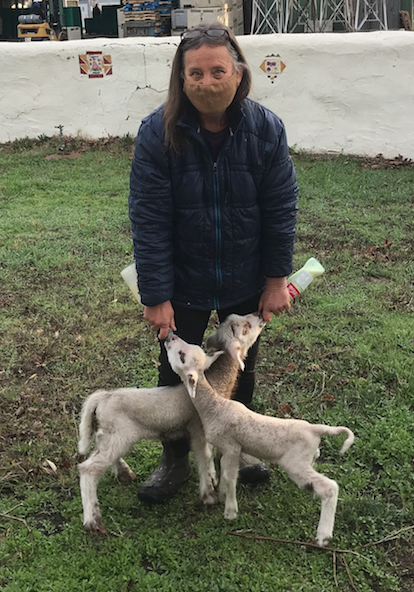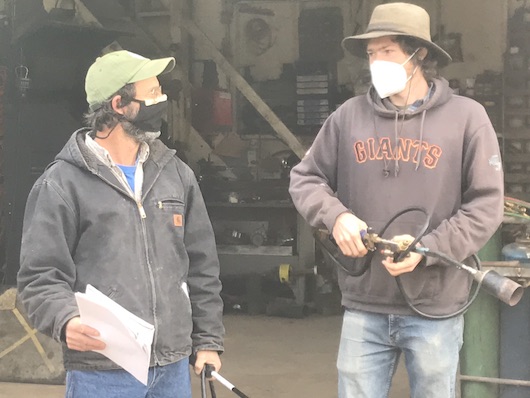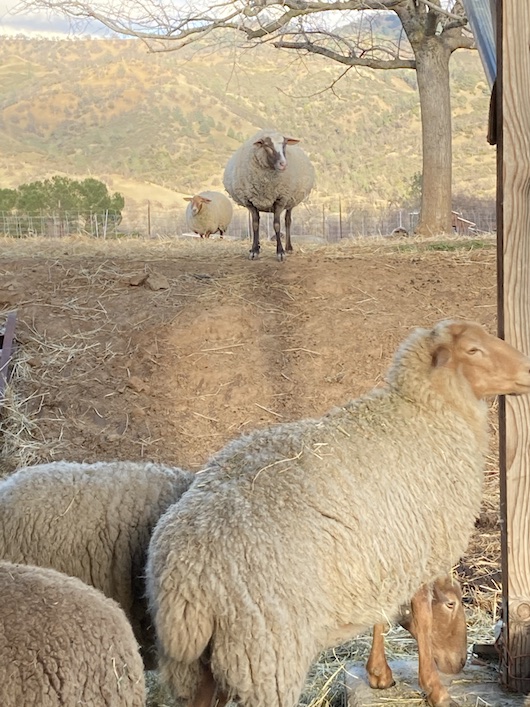
Lamb Count: This morning the lambing crew reported that we have 108 lambs born so far, including 17 sets of triplets. This photo shows Dru feeding the “bummers” — lambs whose Moms needed a little helping hand taking care of the babies. —
Our farming cycle is very linked to the annual calendar cycle and it is a thing for us at Full Belly, before a New Year is in full swing, to look back at what has been learned the year before, hoping to inform our activities in the year to come. Part of that thinking is to review the CSA boxes from the previous year, imagining a household that got a box every week: What did our members eat from the farm in a year of 2020 boxes?
The back story about CSAs says that by eating locally, your food will be fresher, picked at the peak of ripeness, thus more tasty and nutritious. The scientists report that nutrients decline in a weeks time when produce is shipped, with anywhere from 15 to 77 percent loss in the first week, depending on the nutrients being measured. This is one appeal of CSA membership.
The back story also says that buying local is a way to support your community, rather than watching your food budget get sucked into the river of dollars going to corporate headquarters and deep pockets. Agriculture does have a bigger local economic “multiplier” than many other industries, with every dollar spent locally supporting significant additional local spending.
The seasonality of CSAs can be one of their most challenging or rewarding characteristics, depending on your point of view. The Full Belly CSA requires members to adjust their diets in response to changes in the climate here at the farm. It may be that seasonally changing fruits and vegetables are tuned in some way to the needs of local people’s bodies — As seasons change, perhaps particular diets made up of the produce that grows in those seasons, are more suited to the body’s needs?
The boxes last winter (just like now) were packed with immune boosting nutrients from the citrus and the abundant greens: Carrots, leeks, lettuce, broccoli, cabbage, winter squash, potatoes, beets, fennel and even celery root were in appearance. If you ate from the box every week last year, you had 49 bunches of greens — a mix of arugula, bok choi, broccoli raab, chard, collards, mizuna, kale and wild mustard.

These are the two Andrews: Andrew (Farm Partner) and Andrew (Intern), getting ready to go out and flame the weeds in the young carrot field.
The highly anticipated beginning of asparagus harvest at the farm was a welcome sign last year that spring boxes were on the way. The boxes didn’t change a whole lot last year in the spring compared to winter, other than a few surprises like artichokes and radishes, but around May, the asparagus stopped and strawberries started. Then some early stone fruit provided a hint that things were warming up. Last year there were eight weeks worth of asparagus.
The warming trend continued as zucchini was added to the mix in the boxes. The bunched greens and carrots continued into June, but green beans, cucumbers, basil and stone fruit soon became very common. Melons and tomatoes came on in the first week of July, along with peppers and eggplant. We put Shishito peppers into the boxes 11 weeks last summer, a bit unusual compared to other years. A fairly standard diet in the deep summer was tomatoes, eggplant, melons, peaches, peppers, onions and potatoes. Potatoes are a staple at Full Belly — They were in the boxes 18 weeks last year. The summer boxes are always full of sweet, juicy. thirst-quenching and stamina-building fruits and vegetables, perfect for heat and outdoor activities.
The slide into Fall can be gradual. Last year some Kabocha squash turned up early, a sign that something was shifting — we put winter squash in the boxes 22 times last year. The green beans and eggplant hung on into the end of October, but all of a sudden, at the end of September, we were back to greens. The Fall fruit was an exciting mix, with apples, Asian pears and grapes popping in and out of the boxes. When pomegranates appeared in the late Fall, it was a sign that the season was moving towards winter again.
Every year the specifics change, but the basics of the Full Belly box are pretty constant to that outline. Hopefully the seasonal changes in the produce correspond to some way to the tides and seasons of our member’s needs.
Thank you for your membership with the farm, and Blessings on Your Meals.
Judith Redmond

This photo shows some still VERY pregnant moms.
